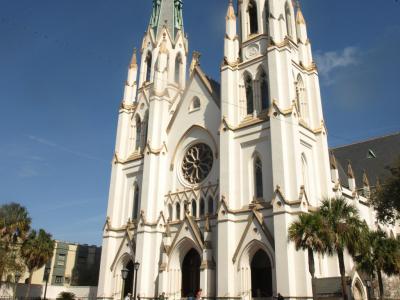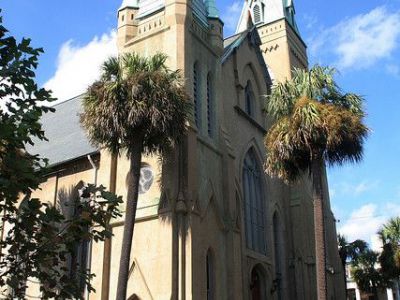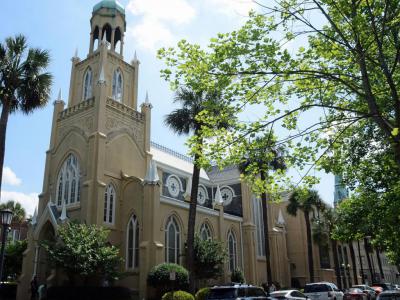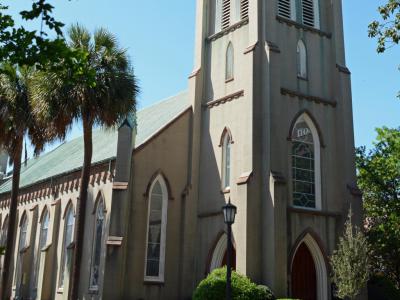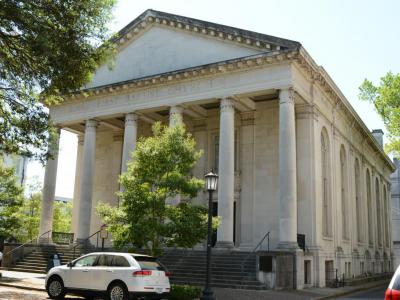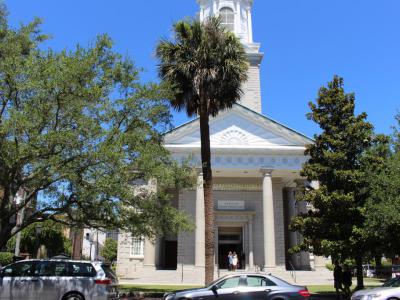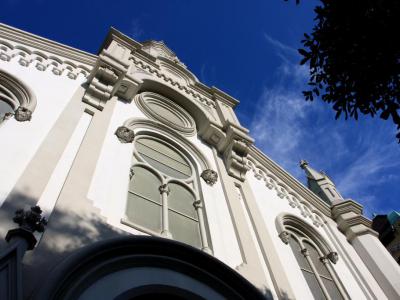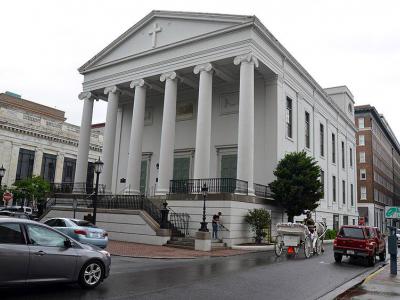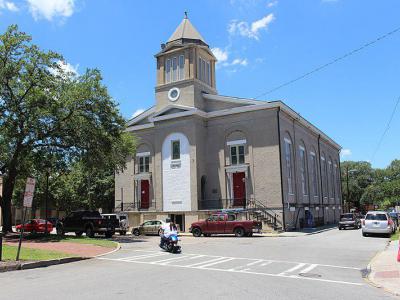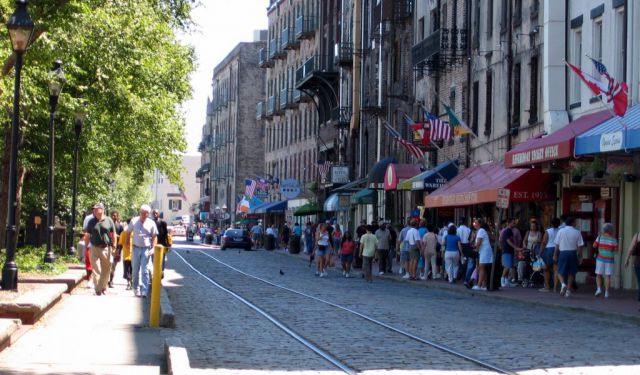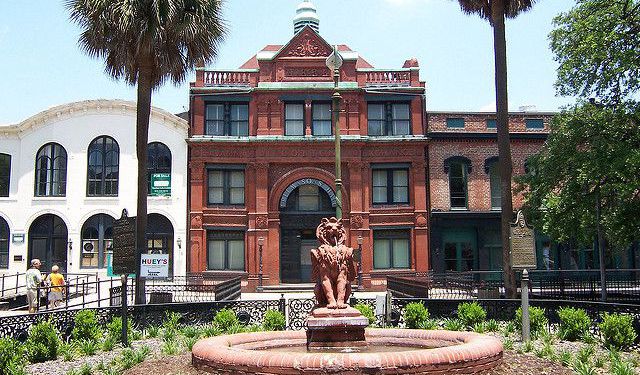
Savannah's Historical Churches (Self Guided), Savannah
The conspicuous churches of various styles and denominations – Catholic, Baptist, Lutheran, Presbyterian, Unitarian, and Methodist – dot the cityscape of Savannah, Georgia, in abundance. With their spires reaching high, as if attempting to touch heaven, these churches stand like sacred sentinels, guarding the city's spiritual heritage and illuminating its architectural grandeur.
The iconic 19th-century Cathedral of St John the Baptist, on Lafayette Square, is one of Savannah's most recognizable landmarks, showcasing a distinctive Gothic Revival exterior. The Wesley Monumental United Methodist Church is known for its impressive Victorian Gothic appearance, enhanced with a tall steeple.
The Independent Presbyterian Church, originally founded in 1755, is one of the oldest temples in the city. The First Baptist Church of Savannah is one of the oldest Baptist congregations in Georgia and is also a striking piece of Greek Revival architecture. Another long-timer, the First African Baptist Church holds the distinction of being one of the oldest African American Baptist congregations in the United States, established in the 1770s.
In the heart of Savannah, these and other solemn “hymns in stone” resonate with the echoes of history and are living testaments to the intersection of faith and artistry, where divine inspiration found its expression in architectural marvels.
For centuries, the churches of Savannah have been like celestial lighthouses, guiding souls through the storms of life towards the shores of salvation. If you're a believer, you may wish to walk through their hallowed halls yourself and feel, in their embrace, how the sacred and the secular converge, reminding us that beauty and divinity often dwell hand in hand.
The iconic 19th-century Cathedral of St John the Baptist, on Lafayette Square, is one of Savannah's most recognizable landmarks, showcasing a distinctive Gothic Revival exterior. The Wesley Monumental United Methodist Church is known for its impressive Victorian Gothic appearance, enhanced with a tall steeple.
The Independent Presbyterian Church, originally founded in 1755, is one of the oldest temples in the city. The First Baptist Church of Savannah is one of the oldest Baptist congregations in Georgia and is also a striking piece of Greek Revival architecture. Another long-timer, the First African Baptist Church holds the distinction of being one of the oldest African American Baptist congregations in the United States, established in the 1770s.
In the heart of Savannah, these and other solemn “hymns in stone” resonate with the echoes of history and are living testaments to the intersection of faith and artistry, where divine inspiration found its expression in architectural marvels.
For centuries, the churches of Savannah have been like celestial lighthouses, guiding souls through the storms of life towards the shores of salvation. If you're a believer, you may wish to walk through their hallowed halls yourself and feel, in their embrace, how the sacred and the secular converge, reminding us that beauty and divinity often dwell hand in hand.
How it works: Download the app "GPSmyCity: Walks in 1K+ Cities" from Apple App Store or Google Play Store to your mobile phone or tablet. The app turns your mobile device into a personal tour guide and its built-in GPS navigation functions guide you from one tour stop to next. The app works offline, so no data plan is needed when traveling abroad.
Savannah's Historical Churches Map
Guide Name: Savannah's Historical Churches
Guide Location: USA » Savannah (See other walking tours in Savannah)
Guide Type: Self-guided Walking Tour (Sightseeing)
# of Attractions: 9
Tour Duration: 2 Hour(s)
Travel Distance: 2.6 Km or 1.6 Miles
Author: hollyg
Sight(s) Featured in This Guide:
Guide Location: USA » Savannah (See other walking tours in Savannah)
Guide Type: Self-guided Walking Tour (Sightseeing)
# of Attractions: 9
Tour Duration: 2 Hour(s)
Travel Distance: 2.6 Km or 1.6 Miles
Author: hollyg
Sight(s) Featured in This Guide:
- Cathedral of St. John the Baptist
- Wesley Monumental United Methodist Church
- Congregation Mickve Israel
- Saint John's Episcopal Church
- First Baptist Church
- Independent Presbyterian Church
- Ascension Lutheran Church
- Christ Church
- First African Baptist Church
1) Cathedral of St. John the Baptist (must see)
Back in the early days of America, the Roman Catholics were banned from settling in the South out of fear of their potential loyalty to the Spanish crown and possible secession of the southern colonies from the English-controlled North. As a result, Savannah had no Catholic church until 1799, when the French migrants from Haiti, fleeing the French Revolution, established it for the first time. The Cathedral of Saint John the Baptist was begun in 1873. It was commissioned in 1896 upon the completion of the majestic twin spires and addition of stucco and whitewash coating to the brick structure.
The cathedral boasts a number of notable artistic and architectural features, including the Great Rose Window, a Gothic quatrefoil with the image of Saint Cecilia in the center. The windows radiating from the center also contain figures – of players of musical instruments. The Original Window of the Blessed Virgin Mary is one of the few to have survived the great fire that ravaged the city in 1898. The Transept Windows feature the assumption of Virgin Mary into heaven, surrounded by angels and saints. In addition to this, the church houses several murals dating from 1912, depicting saints and other religious figures with the encoded symbols indicating their lives and deaths.
Locals lovingly dub the cathedral "America's Sistine Chapel", referring to its amazing stained glass work, ceiling paintings, and altar. Lovely to look at, this fine piece of French Gothic architecture is like a free 'trip' to Europe, particularly impressive to those who have not traveled extensively outside of the U.S.
Whilst inside, spare some time for a guided tour of the building – you'll be glad that you did. Also, be sure to drop a few bills in the donation box at the exit, which is quite unique, and don't forget to turn the handle.
The cathedral boasts a number of notable artistic and architectural features, including the Great Rose Window, a Gothic quatrefoil with the image of Saint Cecilia in the center. The windows radiating from the center also contain figures – of players of musical instruments. The Original Window of the Blessed Virgin Mary is one of the few to have survived the great fire that ravaged the city in 1898. The Transept Windows feature the assumption of Virgin Mary into heaven, surrounded by angels and saints. In addition to this, the church houses several murals dating from 1912, depicting saints and other religious figures with the encoded symbols indicating their lives and deaths.
Locals lovingly dub the cathedral "America's Sistine Chapel", referring to its amazing stained glass work, ceiling paintings, and altar. Lovely to look at, this fine piece of French Gothic architecture is like a free 'trip' to Europe, particularly impressive to those who have not traveled extensively outside of the U.S.
Whilst inside, spare some time for a guided tour of the building – you'll be glad that you did. Also, be sure to drop a few bills in the donation box at the exit, which is quite unique, and don't forget to turn the handle.
2) Wesley Monumental United Methodist Church
Wesley Monumental United Methodist Church has the distinction of being Savannah's first Methodist church. It was originally established in 1807, and situated at the corner of Lincoln and Oglethorpe until members of the congregation purchased a new space for it on Telfair square. Here, they built Trinity church. When Wesley Chapel closed, the two congregations combined into Trinity Church.
As the congregation grew, they made plans for a new building. They completed the first phase of construction for the current Wesley Monumental United Methodist Church in 1878, but didn't finish until 1890. This was intended to be a monument to two primary Methodist figures, John and Charles Wesley.
The building itself is adorned with stained glass memorial windows, all dedicated to historic Methodist figures. It is constructed in a Gothic architectural style, with tall spires, a 43 foot ceiling, and a magnificent Gothic style organ built by the Noack Company. Fire has threatened the church twice, in both 1946 and 1953. Fortunately, some foresight made sure that the sanctuary was outfitted with a steel ceiling in 1902, so the church's interior was protected from the fire.
Today, Wesley Monumental United Methodist Church stands as a haven for all Methodists, and an enduring monument to key figures in Methodism's history.
As the congregation grew, they made plans for a new building. They completed the first phase of construction for the current Wesley Monumental United Methodist Church in 1878, but didn't finish until 1890. This was intended to be a monument to two primary Methodist figures, John and Charles Wesley.
The building itself is adorned with stained glass memorial windows, all dedicated to historic Methodist figures. It is constructed in a Gothic architectural style, with tall spires, a 43 foot ceiling, and a magnificent Gothic style organ built by the Noack Company. Fire has threatened the church twice, in both 1946 and 1953. Fortunately, some foresight made sure that the sanctuary was outfitted with a steel ceiling in 1902, so the church's interior was protected from the fire.
Today, Wesley Monumental United Methodist Church stands as a haven for all Methodists, and an enduring monument to key figures in Methodism's history.
3) Congregation Mickve Israel
Congregation Mickve Israel, whose name is a Hebrew transliteration meaning "Congregation for the Hope of Israel," stands as a notable Reform Jewish congregation and synagogue in Savannah. Located on East Gordon Street, Monterey Square, this historic site also encompasses a Jewish history museum, adding to its cultural significance.
The congregation's origins date back to 1735, making it one of the oldest Jewish congregations in the United States. Its founders were primarily Sephardic Jews of Spanish-Portuguese descent from London, who settled in the then-new colony in 1733. This deep historical root reflects the congregation's long-standing presence and influence in the region.
The current synagogue, consecrated in 1878, is a remarkable example of Gothic Revival-style architecture. Designed by New York architect Henry G. Harrison, the synagogue's structure is distinctive and thoughtfully crafted. Harrison employed a Christian cruciform plan for the layout, a unique choice for a Jewish synagogue. The building's exterior is further distinguished by its tower, which features an open gazebo-shaped belvedere, topped with a cupola that bears almost Islamic-inspired elements. This eclectic blend of architectural influences underscores the synagogue's unique character and historical context.
The synagogue was officially recognized for its historical and architectural significance in 1980 when it was listed on the National Register of Historic Places. It is also a contributing property to the Savannah Historic District, highlighting its importance within the broader historical narrative of the area.
The congregation's origins date back to 1735, making it one of the oldest Jewish congregations in the United States. Its founders were primarily Sephardic Jews of Spanish-Portuguese descent from London, who settled in the then-new colony in 1733. This deep historical root reflects the congregation's long-standing presence and influence in the region.
The current synagogue, consecrated in 1878, is a remarkable example of Gothic Revival-style architecture. Designed by New York architect Henry G. Harrison, the synagogue's structure is distinctive and thoughtfully crafted. Harrison employed a Christian cruciform plan for the layout, a unique choice for a Jewish synagogue. The building's exterior is further distinguished by its tower, which features an open gazebo-shaped belvedere, topped with a cupola that bears almost Islamic-inspired elements. This eclectic blend of architectural influences underscores the synagogue's unique character and historical context.
The synagogue was officially recognized for its historical and architectural significance in 1980 when it was listed on the National Register of Historic Places. It is also a contributing property to the Savannah Historic District, highlighting its importance within the broader historical narrative of the area.
4) Saint John's Episcopal Church
Saint John's Episcopal Church was founded in 1841 in an attempt to increase the Episcopal presence in America. Its very first members were converts from the Anglican Christ Church, and its first rector was the notable Right Reverend Stephen Elliott.
The building itself was designed by architect Calvin Otis in a Neo Gothic style, and built between 1852 and 1853. It was created to have the look of a simple parish house, though it does have several very interesting features- a ships mast is in the center of the church's only spire, it has several magnificent stained glass windows, and its known for its melodious chimes.
Saint John's stained glass windows are all circa the late 19th century. The church's north and south walls are bordered with a set of fourteen different windows depicting the life of Christ, including the Annunciation, Birth, Flight to Egypt, and Jesus in the Temple, to his Death and Resurrection.
Saint John's Episcopal Church also owns the neighboring Green-Meldrim House. This historic house was occupied by General Sherman during the Civil War, and purchased after the war by Judge Peter Meldrim. Today, it serves as a historical building alongside the church itself, and is a setting for church activities like weddings and get-togethers.
The building itself was designed by architect Calvin Otis in a Neo Gothic style, and built between 1852 and 1853. It was created to have the look of a simple parish house, though it does have several very interesting features- a ships mast is in the center of the church's only spire, it has several magnificent stained glass windows, and its known for its melodious chimes.
Saint John's stained glass windows are all circa the late 19th century. The church's north and south walls are bordered with a set of fourteen different windows depicting the life of Christ, including the Annunciation, Birth, Flight to Egypt, and Jesus in the Temple, to his Death and Resurrection.
Saint John's Episcopal Church also owns the neighboring Green-Meldrim House. This historic house was occupied by General Sherman during the Civil War, and purchased after the war by Judge Peter Meldrim. Today, it serves as a historical building alongside the church itself, and is a setting for church activities like weddings and get-togethers.
5) First Baptist Church
First Baptist Church in Savannah is a historic and architecturally significant congregation that has been an integral part of the city's religious and cultural landscape since its establishment in 1800. Initially the congregation gathered in a meeting house located at Franklin Square. In 1801, Georgia Governor Josiah Tattnall granted the church its perpetual charter, marking the beginning of its long and storied history.
The congregation's current home, a striking example of Greek-Revival architecture, is situated on Bull Street, on the western side of Chippewa Square in Savannah's historic district. This building, notable for being the oldest surviving church building in Savannah, has housed the congregation since 1833. The design of the church was the brainchild of architect Elias Carter. The cornerstone of this iconic building was laid on February 2, 1831, and the construction was completed in 1833, allowing the congregation to relocate to this location.
An important addition to the church came in 1922 with the installation of an organ crafted by Ernest M. Skinner, a renowned organ builder. That same year, the church underwent notable alterations under the guidance of local architect Henrik Wallin. These changes included extending the building's front, cladding it in limestone, and removing the cupola, further enhancing its architectural presence.
A landmark in its own right, the First Baptist Church holds the distinction of being one of the few Southern churches that remained open throughout the entirety of the American Civil War. This highlights not only its resilience but also its significance in the local community.
By 1947, the congregation adopted the name "First" Baptist Church to distinguish itself from other Baptist churches in Savannah, reflecting its pioneering role and historical importance in the city.
The congregation's current home, a striking example of Greek-Revival architecture, is situated on Bull Street, on the western side of Chippewa Square in Savannah's historic district. This building, notable for being the oldest surviving church building in Savannah, has housed the congregation since 1833. The design of the church was the brainchild of architect Elias Carter. The cornerstone of this iconic building was laid on February 2, 1831, and the construction was completed in 1833, allowing the congregation to relocate to this location.
An important addition to the church came in 1922 with the installation of an organ crafted by Ernest M. Skinner, a renowned organ builder. That same year, the church underwent notable alterations under the guidance of local architect Henrik Wallin. These changes included extending the building's front, cladding it in limestone, and removing the cupola, further enhancing its architectural presence.
A landmark in its own right, the First Baptist Church holds the distinction of being one of the few Southern churches that remained open throughout the entirety of the American Civil War. This highlights not only its resilience but also its significance in the local community.
By 1947, the congregation adopted the name "First" Baptist Church to distinguish itself from other Baptist churches in Savannah, reflecting its pioneering role and historical importance in the city.
6) Independent Presbyterian Church
Savannah's Independent Presbyterian Church is called the mother church of all of Georgia's Presbyterians. The church, organized in 1755, was originally housed in a building on land granted by King George II. According to his plan, it would be a house of worship that followed the Doctrine of the Church of Scotland.
One of the church's original buildings was destroyed by fire in 1790, after being used as a magazine and stable by the British during the American Revolution. In 1800, its new building was damaged by a hurricane, and required extensive renovation. The church remained in this building until 1816, when the congregation had outgrown it. Architect John Holden Greene was hired to design and build the new, English restoration style building. It featured Federal windows, Corinthian columns, an elevated pulpit, and soft, natural light. Unfortunately, this original building doesn't survive today- it was completely destroyed by a fire in 1889, replaced with an exact replica of Greene's design by architect William G. Preston, and rededicated in 1891. Today, the church's interior reflects its historic design- some pieces of the interior, like the marble baptismal font, even managed to survive the fire and are still in use.
One of the church's original buildings was destroyed by fire in 1790, after being used as a magazine and stable by the British during the American Revolution. In 1800, its new building was damaged by a hurricane, and required extensive renovation. The church remained in this building until 1816, when the congregation had outgrown it. Architect John Holden Greene was hired to design and build the new, English restoration style building. It featured Federal windows, Corinthian columns, an elevated pulpit, and soft, natural light. Unfortunately, this original building doesn't survive today- it was completely destroyed by a fire in 1889, replaced with an exact replica of Greene's design by architect William G. Preston, and rededicated in 1891. Today, the church's interior reflects its historic design- some pieces of the interior, like the marble baptismal font, even managed to survive the fire and are still in use.
7) Ascension Lutheran Church
Ascension congregation is one of the oldest in Savannah, dating back to 1741. The building itself wasn't completed until 1878, after a string of other temporary churches were built on the current church's lot. It is a combination of Norman and Gothic styles, designed by architect George B. Clarke in 1875.
During the Civil War, the church was turned into a temporary hospital for sick and injured Civil War soldiers. Pew cushions became beds, and the pews themselves were splintered for firewood. This seriously damaged the interior of the church, but not irreparably so. Renovations began in 1875, and the church was fixed up, a second story was added, the Ascension window was installed, and the new building was dedicated by 1879.
The most notable feature of the current church is its magnificent Ascension Window, from which it gets its name. Flanking the Ascension window are stained glass windows featuring scenes taken from the life of Christ. The church also houses other notable works of art, including murals and other stained glass windows. The Luther Rose Window is a large rose window above the Luther window, a stained glass work featuring Martin Luther before the Diet of Worms. A marble altar features a mural of Leonardo da Vinci's Last Supper.
During the Civil War, the church was turned into a temporary hospital for sick and injured Civil War soldiers. Pew cushions became beds, and the pews themselves were splintered for firewood. This seriously damaged the interior of the church, but not irreparably so. Renovations began in 1875, and the church was fixed up, a second story was added, the Ascension window was installed, and the new building was dedicated by 1879.
The most notable feature of the current church is its magnificent Ascension Window, from which it gets its name. Flanking the Ascension window are stained glass windows featuring scenes taken from the life of Christ. The church also houses other notable works of art, including murals and other stained glass windows. The Luther Rose Window is a large rose window above the Luther window, a stained glass work featuring Martin Luther before the Diet of Worms. A marble altar features a mural of Leonardo da Vinci's Last Supper.
8) Christ Church
Christ Church is one of Savannah's oldest churches. This Anglican Church calls itself the Mother Church of Georgia and has been in existence since 1733. It was founded with the creation of Georgia as a colony, and its location was spelled out by General James Oglethorpe in his plan for Savannah. Originally, services took place in the settlement's courthouse.
One of the church's rectors, John Wesley, served for a year between 1736 and 1737. Though he wasn't with the church long, he published a Collection of Psalms and Hymns, which was America's first English hymnal. He was succeeded by George Whitefield, who was instrumental in raising money for the colony's orphanage.
The church's interior is not the original. In 1895, a fire nearly gutted the church. Subsequent renovations gave the church the appearance it has today, including the Ascension windows, which serves as a memorial to the Right Reverend Stephen Elliott, first bishop of Georgia and first and only Presiding Bishop of the Protestant Episcopal Church in the Confederate States of America during the southern secession of the Civil War.
Today, the church serves as a historical site and religious institution. Services are still given on Sundays, including an Evening Eucharist (6pm).
One of the church's rectors, John Wesley, served for a year between 1736 and 1737. Though he wasn't with the church long, he published a Collection of Psalms and Hymns, which was America's first English hymnal. He was succeeded by George Whitefield, who was instrumental in raising money for the colony's orphanage.
The church's interior is not the original. In 1895, a fire nearly gutted the church. Subsequent renovations gave the church the appearance it has today, including the Ascension windows, which serves as a memorial to the Right Reverend Stephen Elliott, first bishop of Georgia and first and only Presiding Bishop of the Protestant Episcopal Church in the Confederate States of America during the southern secession of the Civil War.
Today, the church serves as a historical site and religious institution. Services are still given on Sundays, including an Evening Eucharist (6pm).
9) First African Baptist Church (must see)
The First Colored Church of Savannah (renamed the First African Baptist Church in 1882) is the oldest continuously active African-American congregation in North America. It was formed in 1778 by George Liele, the first black man to be ordained by Baptists to preach in Georgia.
The present church was built by members of the congregation, among whom there were many slaves who, after laboring all day in the fields, would make bricks, lay mortar, and carve pews for the church (that are still in use even today!).
During the turbulent years of the Civil War, this temple was a haven for runaway slaves. The fugitives hid in a four-foot high space between the basement and foundation below, with 'air holes' still visible in the basement floor – in lack of better knowledge, some visitors today erroneously assume these holes to be part of an artistic design. Speaking of the design, worthy of note here are the beautiful stained glass windows depicting Liele and other early church leaders, installed in 1885.
During the 1960s, the First African Baptist Church of Savannah served as a base for the Civil Rights movement. Today, it houses a museum containing archives and memorabilia dated from the 18th century.
Those interested in history in general and that of Savannah in particular, should consider taking a guided tour of the church. The tour takes you through the main temple, upstairs, and in the basement where you can learn about the role of the Underground Railroad.
Guided tours are offered Tuesday through Saturday at 11am, 2pm, and 4pm; and on Sunday at 1pm.
The present church was built by members of the congregation, among whom there were many slaves who, after laboring all day in the fields, would make bricks, lay mortar, and carve pews for the church (that are still in use even today!).
During the turbulent years of the Civil War, this temple was a haven for runaway slaves. The fugitives hid in a four-foot high space between the basement and foundation below, with 'air holes' still visible in the basement floor – in lack of better knowledge, some visitors today erroneously assume these holes to be part of an artistic design. Speaking of the design, worthy of note here are the beautiful stained glass windows depicting Liele and other early church leaders, installed in 1885.
During the 1960s, the First African Baptist Church of Savannah served as a base for the Civil Rights movement. Today, it houses a museum containing archives and memorabilia dated from the 18th century.
Those interested in history in general and that of Savannah in particular, should consider taking a guided tour of the church. The tour takes you through the main temple, upstairs, and in the basement where you can learn about the role of the Underground Railroad.
Guided tours are offered Tuesday through Saturday at 11am, 2pm, and 4pm; and on Sunday at 1pm.
Walking Tours in Savannah, Georgia
Create Your Own Walk in Savannah
Creating your own self-guided walk in Savannah is easy and fun. Choose the city attractions that you want to see and a walk route map will be created just for you. You can even set your hotel as the start point of the walk.
African-American Heritage Tour
The history of America has many themes, but the theme of African American history that has touched many the most is the theme of resilience. Indeed, African Americans' enduring strength and resilience in the face of adversity have been the subjects of many songs, books, and movies in recent years. Savannah, Georgia, whose African-American population makes up about 60 percent of total... view more
Tour Duration: 2 Hour(s)
Travel Distance: 4.4 Km or 2.7 Miles
Tour Duration: 2 Hour(s)
Travel Distance: 4.4 Km or 2.7 Miles
Historical Houses Walking Tour
Savannah, Georgia breathes history. You can feel it in the cobblestone alleyways and quaint squares dotting the city. An enchanting walk through the heart of Savannah's Historic District (one of the most carefully preserved in the United States) highlights an array of beautiful homes.
Saved by the forward-thinking residents from being bulldozed in the 1960s, these gorgeous structures (with... view more
Tour Duration: 2 Hour(s)
Travel Distance: 3.7 Km or 2.3 Miles
Saved by the forward-thinking residents from being bulldozed in the 1960s, these gorgeous structures (with... view more
Tour Duration: 2 Hour(s)
Travel Distance: 3.7 Km or 2.3 Miles
River Street Sightseeing and Shopping
The story of Savannah's River Street begins in 1733 with General James Edward Oglethorpe's landing on the bank of the Savannah River and founding the British colony of Georgia. Today, the cobble-stoned River Street caters to a variety of interests, combining the rustic beauty of the past with the energy of the present.
The half-mile-long promenade is one of the city's major... view more
Tour Duration: 1 Hour(s)
Travel Distance: 0.7 Km or 0.4 Miles
The half-mile-long promenade is one of the city's major... view more
Tour Duration: 1 Hour(s)
Travel Distance: 0.7 Km or 0.4 Miles
Savannah Introduction Walking Tour
Savannah may not be the whole of Sweet Georgia, but no Georgia is complete without Savannah, that's for sure.
This coastal city is named after the river upon which it stands, whose name is likely to be the variant pronunciation of “Shawnee”, the Native American tribe which inhabited the area in the 1680s. Alternatively, it could have derived from the Spanish “sabana”, referring to... view more
Tour Duration: 2 Hour(s)
Travel Distance: 3.7 Km or 2.3 Miles
This coastal city is named after the river upon which it stands, whose name is likely to be the variant pronunciation of “Shawnee”, the Native American tribe which inhabited the area in the 1680s. Alternatively, it could have derived from the Spanish “sabana”, referring to... view more
Tour Duration: 2 Hour(s)
Travel Distance: 3.7 Km or 2.3 Miles
The Most Popular Cities
/ view all
